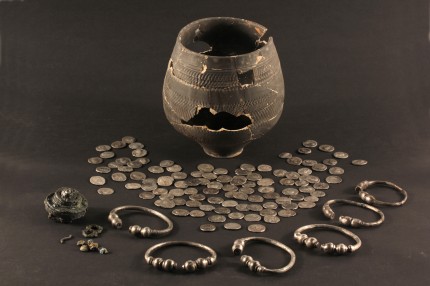Archaeologists excavating the future site of the Rotterdamsebaan access road in The Hague announced on Friday that they’ve unearthed a Roman-era pot containing a hoard of coins and jewelry. The contents of the pot were discovered fused together in a large lump of metal. Conservators were able to separate the individual parts of the mass and discovered 107 silver coins, six silver bracelets, a large silver plated fibula (cloak brooch) and some glass beads that were probably on a chain that has now disintegrated. The silver bracelets look the same, but there are small differences between them that indicate they are three matched pairs.
Restorer Johan van der Helm did such a fine job detangling the rusted lump and cleaning the coins that in the end all 107 coins were readable. They are all silver denarii, a very valuable collection at a time when brass coins were far more common in circulation. The oldest coin dates to the reign of the emperor Nero (54-68 A.D.), the youngest to the reign of Marcus Aurelius about a century later (161-180 A.D.). One extremely rare coin was struck under the reign of Emperor Otho who only ruled three months, from January 15th to April 16th 69 A.D., the second in the turbulent Year of the Four Emperors which came to a close with the ascent of Vespasian.
This find doubles the number of Roman coins discovered in The Hague, which in the 2nd century was sparsely populated countryside in Rome’s Germania Inferior province. The area that is now The Hague was just south of the estuary of the Rhine, the empire’s western frontier, so there were fortifications here and there but the regional capital was the nearby town of Forum Hadriani, modern day Voorburg, which was the northernmost Roman city in continental Europe. It was abandoned in the wake of Saxon raids in around 270 A.D.
Earlier this fall, the Rotterdamsebaan excavations uncovered the remains of two Roman houses and several wells close to where the coins were unearthed. It seems to have been a small farming community. Since the hoard was buried all at once rather than deposited over time as savings, it was either an offering to the gods or the earthly goods of an area resident seeking to protect them from marauders.
The hoard is now on display at the Historical Museum of The Hague.
